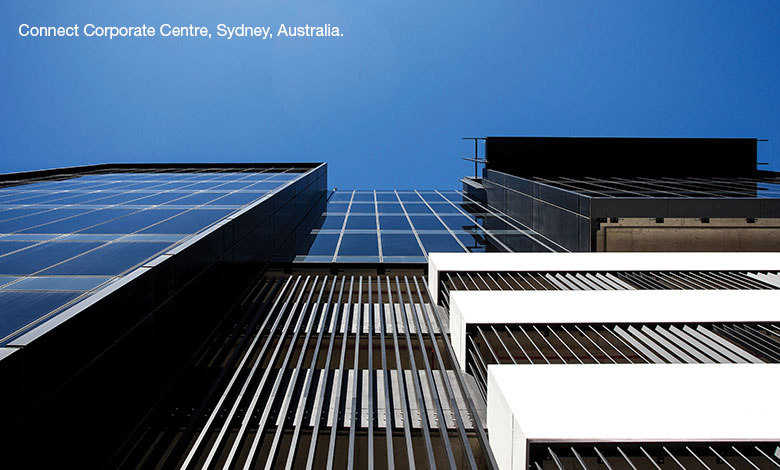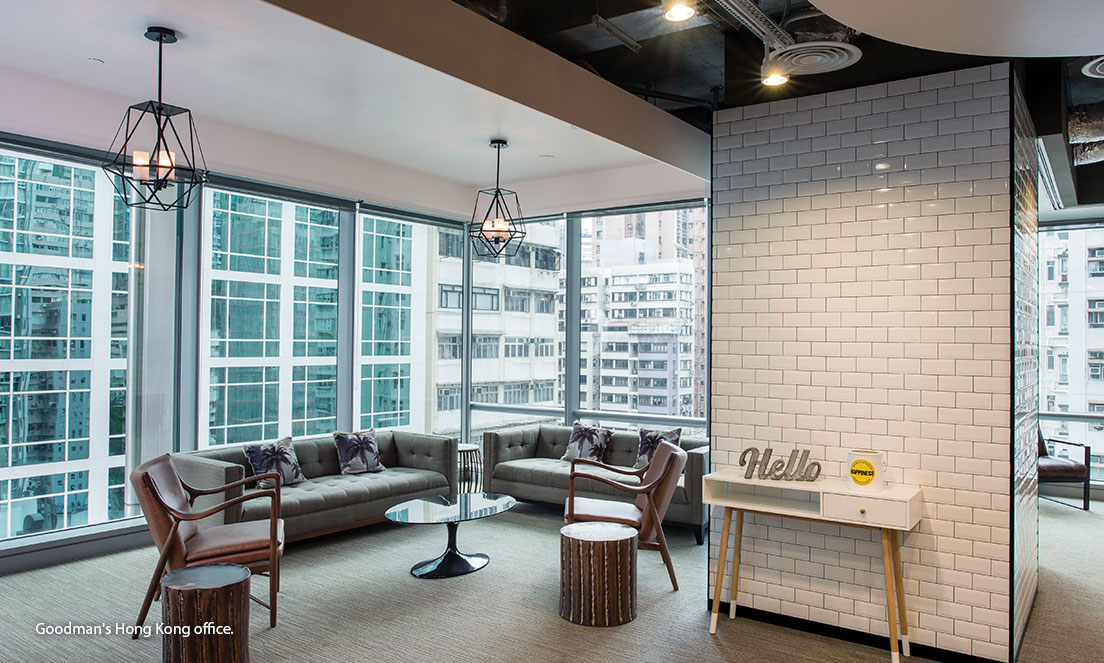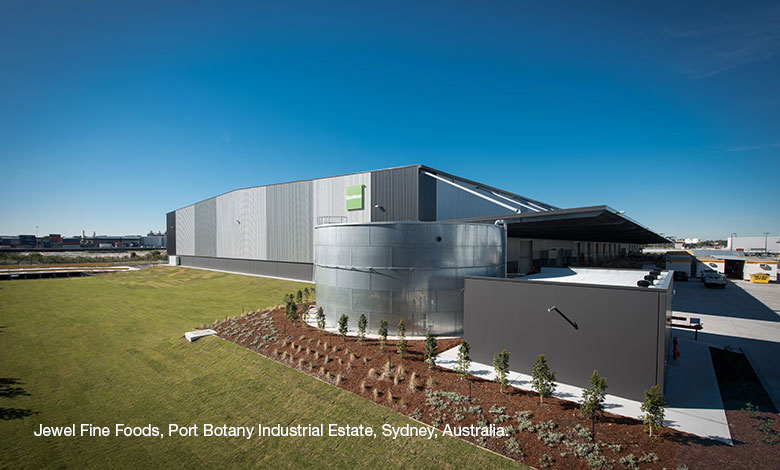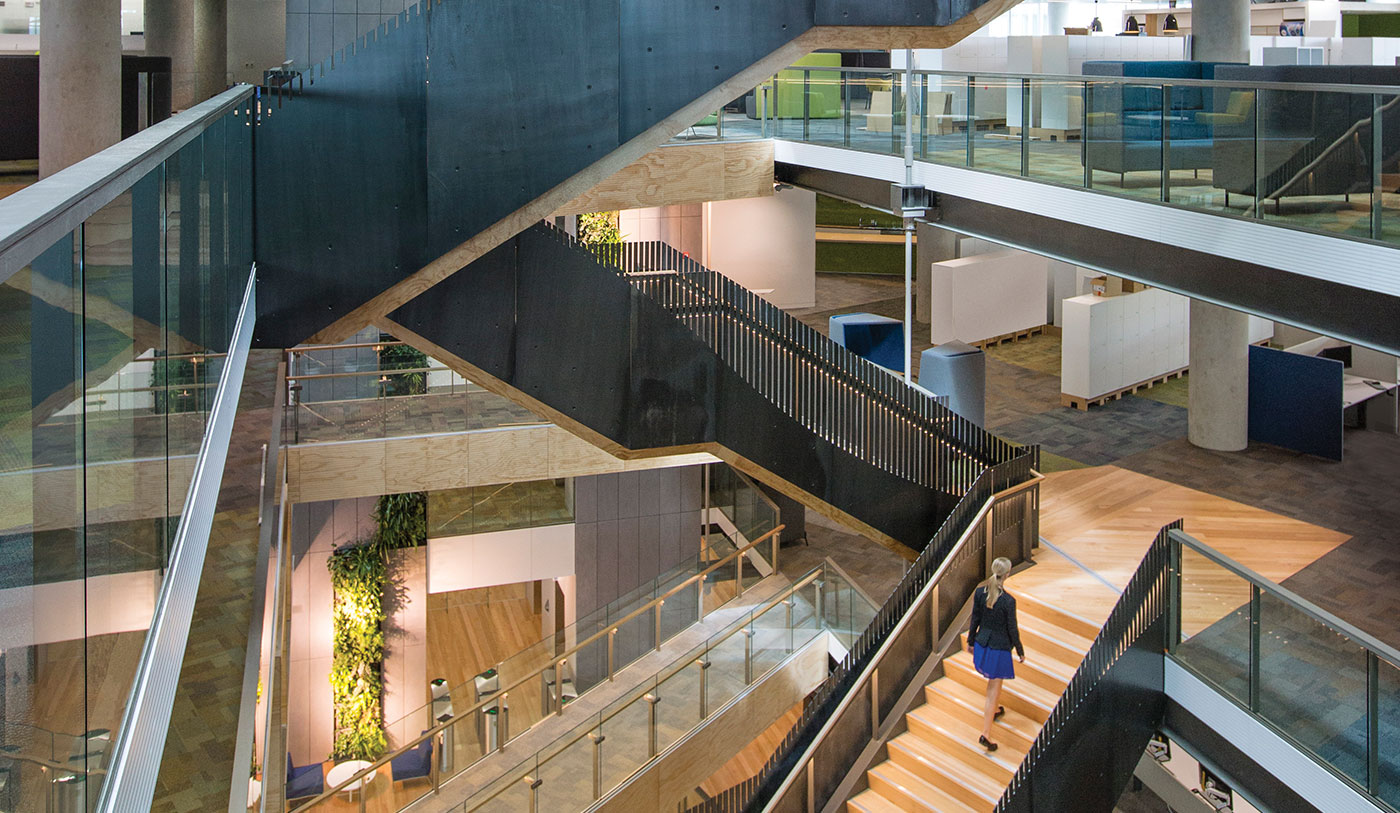SUSTAINABILITY
It’s been a strong year for Goodman, with our commitment to Corporate Responsibility and Sustainability (CR&S) playing a positive role in this success.
Throughout the year, we’ve worked hard to achieve consistency across the business to deliver our sustainability initiatives. To get there, we’ve built our internal knowledge and capacity, an investment which is enabling our teams to collaborate and respond to global trends such as the growth in consumerism, urbanisation and e-commerce.
Sustainability is partly about embracing innovation. The concept fits well with Goodman’s drive to improve the quality of our properties, and represents just one way we are capitalising on the shifting dynamics across the logistics sector.
Our focus on sustainability also ensures we continue finding efficiencies across the business. While this is a natural fit for Goodman, it’s also a key driver of our customer-focused business strategy.
Our sustainability strategy is reviewed regularly to ensure it supports, and is aligned with, Goodman’s business strategy. Over the last year, we further revised our sustainability approach to deliver our activities and targets across four main areas.

- Sustainable development – striving to improve the sustainability of our developments, through innovation and working with customers to evaluate and incorporate design initiatives.
- Asset management – managing and investing in our assets to improve efficiency, long-term competitiveness and resilience.
- Corporate performance – measuring our impact, improving our overall performance and engaging regularly with our key stakeholders.
- People and community – inspiring and challenging our people, and supporting various community based groups through the Goodman Foundation.
FY2016 Highlights:
- Certified green developments completed in Australia, New Zealand, Japan, China, Continental Europe, the United Kingdom and the United States;
- Over 16 MW of solar capacity now installed across Goodman’s Japanese portfolio;
- 5.5 NABERS Energy rating for Goodman’s head office in Sydney;
- Further transition to LED lighting as our standard warehouse lighting;
- LEED-certified fitout for Goodman’s Hong Kong office; and
- Submissions to the Global Real Estate Sustainability Benchmark for seven Goodman Partnerships.
MATERIAL ISSUES
During the year, Goodman completed an operational review to ensure its approach to sustainability encompassed what we believe to be our most material issues. The four focus areas that comprise our overall strategy all include issues that are relevant to our business, brand and the overall sustainability of our operations. These include:
- Designing for good environmental performance;
- Building resilience;
- Operational efficiency;
- Energy use and greenhouse gas emissions;
- Quality of customer service;
- Ethical operations and strong governance;
- Workplace health and safety;
- Workplace diversity; and
- Wellbeing of our communities.
Understanding and prioritising our material issues is a critical part of Goodman’s strategy setting process. We utilise the following avenues to ensure our teams remain aware of, and in touch with, current and emerging issues and industry trends:
- Engagement with our key stakeholders, as shown in the ‘Our stakeholders’ graphic below. This includes regular communication with investors, customers and employees;
- Engagement with Goodman’s senior management, including the senior executive team based in Sydney and our regional leaders;
- Actively engaging with the broader industry, including industry committees and peer groups, as well attendance at conferences and seminars; and
- Deeper research into specific industry trends and emerging themes identified as potentially being of high materiality.
STAKEHOLDER ENGAGEMENT
Globally, Goodman’s team engage regularly with our stakeholders to ensure our approach to sustainability remains relevant and consistent, and continues to meet stakeholder expectations.
We engage through a range of channels and processes depending on the stakeholder, but typical channels include investor updates and committee meetings, property tours for investors and analysts, property management activities and customer meetings, industry forums and events, and through the Goodman website.
The image below gives an overview of how we communicate with each of our stakeholder groups.

Investors
Goodman communicates extensively with its investors. This is undertaken regularly and in different ways, including annual reports, half year results, quarterly updates, email alerts, investor newsletters, general communications and market announcements. Goodman’s website includes extensive information in the “Investor Centre” section, ranging from ASX announcements and media releases, to reports and newsletters, financial information and presentations, and upcoming events.
Goodman holds an annual strategy update, where investors and analysts have the opportunity to hear market update presentations on all of Goodman’s regional operations, while Securityholders are invited to attend Goodman Group’s Annual General Meetings either in person or by proxy.
Customers
The customer is at the core of Goodman’s own, develop and manage business model, and drives our focus on delivering superior service and maintaining our high customer retention rates. At a global level, our approach is to build strong relationships to attain a deeper understanding of their unique business and real estate needs. At the local level, our property management teams meet regularly with our customers to discuss a range of matters relating to their current leased space and future real estate requirements.
Environment
Managing our environmental compliance obligations across the Group remains a high priority for Goodman. This extends not only to our regulatory obligations in relation to contamination, pollution and remediation, but also to meeting our commitments to environmental stewardship and enhancing the local amenity of our assets.
Government
Goodman’s risk and compliance team is responsible for ensuring current and emerging laws and regulations are managed appropriately. In doing so, regular formal and informal communications are undertaken with regulators, and also through industry associations and councils of which Goodman is a member.
Community
Our primary vehicle for engaging with our communities is the Goodman Foundation, which supports charitable organisations that help those in need throughout our communities. The Goodman Foundation provides two programmes for Goodman’s employees, being good+deeds and good+heart, both of which provide employees with opportunities to directly participate and support any of its partner organisations.
Employees
Goodman engages constantly with its employees through a variety of channels, including:
- Regular staff presentations on business performance and results;
- Staff newsletters and updates;
- Development programmes;
- Staff surveys, including IT systems and our ‘Space To Work’ working platform; and
- Goodman’s performance management system.
SUSTAINABLE DEVELOPMENT
It was a busy year for our development teams, with $3.2 billion of new developments completed across Goodman’s operating regions.
Incorporating sustainable design initiatives into our industrial developments remains a challenge, as factors including functionality, location and cost remain primary decision drivers. Our approach is to get the basics right relating to site orientation, natural light, smart lighting, efficient air conditioning, rainwater capture and efficient landscaping, and then target local opportunities and priority issues.
As a long-term owner of our properties, we look for feasible design options that provide tangible benefits to our customers, enhance leasing appeal and add value to the property.
Last year, developments completed in Australia and New Zealand represented 26% of all projects completed globally. Typical sustainability features we incorporated into our Australian and New Zealand developments include:
- Translucent roof sheeting to maximise natural lighting into the warehouse;
- Fully automated T5 fluorescent or LED lighting;
- Electrical sub-metering;
- Glare control;
- Low VOC materials;
- Rainwater harvesting;
- End-of-trip facilities; and
- Drought-tolerant native landscaping.
CASE STUDIES
Connect Corporate Centre, Sydney, Australia
Among the developments we completed in Australia last year was Connect Corporate Centre, a new office development located in the business precinct of Mascot and only a few minutes from Sydney Airport.
This four-storey 5,600 sqm office building was designed with sustainability in mind, and is located adjacent to the new 5 Star Pullman Hotel, another Goodman development. Sustainability features include:
- 4 Star Green Star design certification and 4.5 star NABERS Energy rating;
- A large glass façade to maximise natural light across the office floors;
- Automated efficient lighting with sensor controls;
- Innovative design providing flexible workspaces;
- Substantial rainwater harvesting; and
- End-of-trip facilities for cyclists, including bike racks, lockers and showers, and an on-site gym.

Oakdale Central Industrial Estate, Sydney, Australia
At Goodman’s Oakdale Industrial Estate in Western Sydney, a campus-style feel is attracting customers like DHL Supply Chain, who now occupy six separate facilities at the Estate, and benefit from easy access to the M4 and M7 motorways. The two new developments completed during the year for DHL Supply Chain have a combined area of 58,185 sqm and incorporate a range of sustainability features, including LED lighting throughout both of the warehouses. Other sustainability features include:
- Over 50,000 L of rainwater harvesting capacity for irrigation and amenities;
- Insulated warehouse walls;
- Solar hot water heating;
- Light zoning and motion sensors to reduce energy consumption; and
- LED high bay lighting throughout the warehouse.


Goodman Business Park Chiba Newtown, Tokyo, Japan
Sustainable developments aren’t just about how buildings function, they must also consider how people use them. In Japan, Goodman’s Business Park in Chiba Newtown, Tokyo was designed with comfort and customer amenity as priorities. Last year we completed Stage 1 of this master-planned, multi-stage development, where a free share bicycle service and a dedicated bus service to the nearest train station will form an important part of a dynamic mix of amenities, including retail, restaurants, café and a child care service.
The building features high quality internal areas to enhance comfort, cutting-edge LED lighting throughout the warehouse to reduce power consumption and a large 2.7 MW solar PV system on the roof to generate green energy. Sustainability features include:
- 2.7 MW solar PV roof-top solar system;
- LED lighting throughout warehouse and common areas;
- High quality internal spaces and customer amenity;
- High level of green and open space; and
- Shared bicycle system for commuting from home/train station to the facility.



Fonterra Centre, Auckland, New Zealand
It was a busy year in New Zealand. A number of new developments were completed, with a highlight being a new 16,000 sqm head office for Fonterra in Auckland. Working in collaboration with Fonterra, Goodman delivered a 5 Star, Green Star purpose-built office complex that is modern, comfortable, innovative and highly sustainable.
Sustainability is woven throughout the design. A large double-glazed atrium fills the building with natural light, while a variety of workspaces and an internal staircase encourage collaboration across the activity-based work environment. Sustainability features include:
- 5 Star Green Star Design certification;
- Large atrium and skylight contributing to good natural light levels;
- Outdoor air supplied from exposed stainless ducts on the north and south external elevations;
- Internal green wall irrigated from harvested rainwater; and
- Property Council NZ ‘Excellence’ award in commercial category and ‘Merit’ in the green building category.



Sustainability remained a strong focus in our UK developments last year, with our development team staying committed to achieving a minimum BREEAM rating of ‘Very Good’ for each of its new developments.
One project which met this goal in the last twelve months was our 25,000 sqm Angle 265° at Medway Commercial Park in Kent. This high quality logistics facility incorporates a carbon neutral cladding solution and electric car charging points, which helped it achieve a BREAAM rating of ‘Very Good’ and an Energy Performance Certificate ‘A’ rating.
Last year, our UK development team also progressed its first development assessment under the “Planet Mark” scheme. This independent third party scheme provides an assessment of the carbon footprint for a new development throughout its life cycle.
In the United States, over 167,000 sqm of new developments were completed throughout the year, while over 200,000 sqm were in progress at 30 June 2016. One of these completed developments is the LEED-certified Goodman Commerce Center Eastvale, Southern California, where electric vehicle charge points, drought-tolerant landscaping, prismatic skylights to maximise natural lighting and LED lighting are all featured.
In Continental Europe, consistency and our commitment to quality were key themes. This continued focus has ensured our development product is highly regarded in the European market, most notably within the e-commerce sector, where Goodman has now delivered in excess of 1.5 million sqm of space.
To ensure our properties remain highly competitive, our development teams take a customer-focused approach, collaborating with them to deliver innovative and sustainable property solutions. The recently completed 28,000 sqm logistics property developed for eBay Enterprise at Goodman Halle Logistics Centre in Germany is one such example.
The facility achieved a Gold rating under the DGNB rating scheme and incorporates a range of sustainable design features including an innovative timber roof structure, energy efficient fluorescent lighting, efficient internal heating and native plants and landscaping to reduce water consumption.
In China’s booming logistics market, Goodman has remained focused on quality and consistency. We’ve incorporated fundamental sustainability initiatives into each of our developments, including the landmark Goodman Qingpu Centre in Shanghai.
Completed in December 2015, the Qingpu Centre is Goodman’s first three-storey distribution facility in China. The 110,000 sqm logistics property is currently targeting LEED certification, and incorporates multiple sustainability features, including skylights across approximately 4% of the roof area, providing natural light throughout the warehouse. The skylights are just one way the building is reducing its energy consumption, and will be especially effective when partnered with the energy efficient T5 lighting installed in the warehouse.

LEADING BY EXAMPLE
In Hong Kong, our team moved into its new green office space, where Goodman’s ‘Space To Work’ principles were put into practice. The activity-based fitout features a variety of work spaces, with collaborative sections, private areas, formal spaces and relaxed work spaces all designed in to the build.


The result is flexible, but it’s also sustainable. The new office has been designed to achieve the LEED Gold Standard (Commercial Interiors) and incorporates LED lighting with motion sensors, drinking water filtration and an air purification system. We’ve also used locally sourced and sustainable materials internally.
IMPROVING PERFORMANCE
Goodman has always seen the performance, presentation and efficiency of our properties as a core priority. Over the last year, we have maintained that focus across the globe.
In Australia, we’ve seen the results of several lighting upgrades completed over the past few years, particularly in car park and estate common areas. The business case for lighting upgrades continued to strengthen, driven by the reduction in energy costs for our customers, the lower cost of LED technologies, lease renewals and long-term asset valuations.
Once again, the Buildings Alive energy monitoring system has produced positive results across our Australian office portfolio over the last year. This system tracks live energy consumption data across the portfolio and contributed to a 5% reduction in energy consumption across our office portfolio during the last twelve months.
In New Zealand, we transformed Show Place Office Park in Christchurch into a highly sustainable and energy efficient office asset. The upgrade aimed to both reduce operational costs and the building’s carbon footprint, to create a healthier environment for staff. It worked. This successfully achieved an approximate 40% reduction in energy consumption and New Zealand’s first 5 star NABERS Energy whole building rating. Key sustainable features include a Variable Refrigerant Flow HVAC system with heat recovery, CO2 sensors, LED lighting, daylight harvesting and occupancy sensors.
In Asia, our Property Services team in Hong Kong participated in the Power Smart Programme, which aimed to increase awareness and identify improvement opportunities across the Hong Kong portfolio. When we implemented the results, seven Goodman properties recorded energy reductions of 5% or more.
The improvements continued on projects outside of the scope of the Power Smart Programme. LED lighting upgrades with sensor controls at Goodman’s Tuen Mun Distribution Centre and the Western Plaza were just one example, a move estimated to save approximately HK$750,000 p.a. in energy costs across the two properties.
In Continental Europe, we also focused on lighting, by continuing upgrades to LEDs across our portfolio. Several upgrade projects were completed during the year, and once fully completed, our European portfolio will consist of approximately 1 million sqm of space equipped with LED lighting.
Shorter term, these upgrades will reduce our customers’ energy consumption and associated energy costs, while long term they will increase leasing competitiveness and property values.

RENEWABLE ENERGY IN JAPAN
The market conditions in Japan support investment in renewable energy on the roof tops of our buildings. Last year we installed a further 2.7 MW of solar PV capacity on the roof of the recently completed Goodman Business Park at Chiba Newtown, Tokyo.
This latest installation increases Goodman’s solar PV capacity in Japan to over 16 MW of renewable energy.
AUSTRALIAN GREENHOUSE GAS EMISSIONS
The year saw a decrease in greenhouse gas emissions for Goodman’s Australian operations. The reduction in emissions to an estimated 39,548 tC02-e was mainly due to further sub-metering of customer power consumption, increased efficiencies across the portfolio, and asset sales completed during the year.
Our calculation includes scope 1 and 2 emissions generated from Goodman’s Australian property and building management services, as well as assets owned directly by Goodman and those within our Australian managed Partnerships. Where sub-metering allows, this does not include the GHG emissions of our customers.

